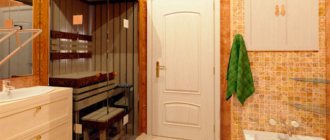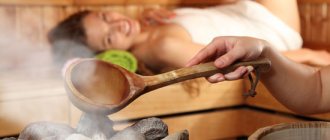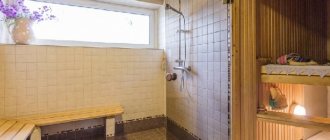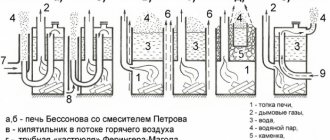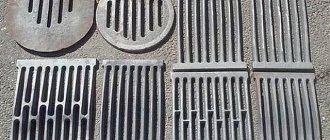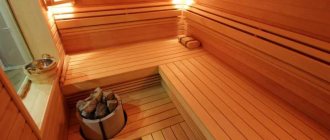Baths in Rus' have long been held in high esteem. It was a favorite place for the whole family, where they could relax and unwind, restore health, and carry out deep cleansing of the body and hygiene procedures. They were treated in the baths and gave birth. It was a whole home complex for every family need. In the modern world, traditional baths, although they have retained their originality, have been somewhat transformed into more comfortable and functional saunas.
The site presents projects of Finnish houses with a sauna, recommendations from experts on use, as well as advice from experienced bath attendants on how to spend time in a Finnish sauna with maximum benefit.
Brief overview of the article
- The emergence of saunas
- What does a Finnish sauna look like and its purpose?
- Differences between a bathhouse and a sauna
- Why visit the baths
- Features of the procedures
- Variety of designs for saunas
- Ready-made complexes
- Makeshift buildings
- Construction materials
- Use of ovens
- Photo of a Finnish sauna
The emergence of saunas
There are more than three million saunas in Finland alone. The tradition of steaming appeared two thousand years ago. The first steam rooms were deep pits lined with stones and heated on one side. The word comes from Finnish and Sami dialects. And the emergence of Finnish saunas was facilitated by a happy accident.
As an ancient legend says, one Finn’s roof began to leak and raindrops fell on the hot coals. This filled the room with a pleasant, warm steam from the evaporation of water. Over time, a mandatory procedure appeared involving dousing with cold water or diving into snowdrifts.
Hammam
Despite the fact that reproducing a Turkish hammam is much more expensive for the average Russian than the same sauna, this type of national baths is still gaining popularity.
BY THE WAY! Calling this type of baths “Turkish” is not entirely legitimate, because it is widespread throughout the East - from Arabia to Central Asia, and the source for them was... Roman baths. But we are already used to it.
The problem is that for a Turkish bath you need a very specific room with a ceiling that has either the shape of a dome or a vault.
And if you do everything according to the rules, then you won’t be limited to one room. The layout of a classic hammam is similar to a palm, where there is a central room with an exit to several smaller ones. In the smaller ones they accept procedures, in the central one they communicate. In other words, the classic hammam is a public bath, not a personal one.
But today this issue can be easily resolved - an individual hammam requires the same room with a domed or vaulted ceiling so that the condensation flows down it onto the walls and does not drip on people - such a room can be one with a lounger and a traditional washbasin.
And the second prerequisite is a room for generating water vapor , where the bathhouse equipment is located.
Materials
Due to the fact that the humidity in a Turkish bath reaches a record 100%, the main requirement for the materials used in it will be water resistance.
stone and meet this requirement . Metals are only stainless, but they have no special use there. Wood should absolutely not be used as the main or finishing material for this type of bathhouse.
But most often tiles are used to decorate a Turkish bath. Of course, there are very expensive baths where massive pieces of stone are used as sun loungers, where the walls are literally decorated with stone panels. But a more common budget option is finishing with ordinary ceramic tiles. This can be small mosaic tiles, or larger ones - at the request of the owner.
Styles
The choice of tiles is not accidental. After all, it not only meets the requirements of water resistance, but is also the basis of the ornaments for which the oriental style is famous. In fact, both baths and mosques of the Muslim world were decorated with tiles.
So the owner of the hammam will only have to decide on the choice of the eastern country ornamental style he likes the most. It is not for nothing that we mentioned above that this bathhouse is widespread throughout the Muslim East - this significantly expands the possibilities of its decoration. Each country has its own unique style, its own peculiarity that can be emphasized.
Hammam, tiled. Photo StroySpaComplex
On the other hand, if there is no desire to somehow emphasize the Eastern origin, you can take abstractions and chaotic patterns , fortunately, tiles are produced in a variety of colors and patterns.
So, to exaggerate it completely, you can either choose ethno or abstraction.
What does a Finnish sauna look like and its purpose?
The photo of a Finnish sauna shows the differences between a Russian bath and a sauna, and presents possible options for arranging a steam room for small and large rooms.
You can set up a small sauna in a city apartment, you can use public baths, and for those who like frequent bath procedures, there are options with separate sauna houses in a rural, picturesque, natural area. Country buildings are rectangular houses with changing rooms, steam rooms, terraces and swimming pools.
As the Finns themselves, who know a lot about saunas, believe, you can’t drink alcohol, talk loudly, or figure out problems in steam rooms. Steam helps to get rid of vices and bad habits. If you are invited to the sauna, then this shows special honor. Taking a steam bath in a sauna is a kind of ritual of cleansing and restoration.
Door and paneling
It's time to install the door. Using parts #10 and 12 this will be easy. You already have the ceiling lined. There is a hole in the ceiling with a ventilation valve. Wires for lamps and heaters are installed in the walls. If you want to install the control panel outside the sauna, now is the time to do it (run the cable from the control panel installation location to the connection block of the heater). The temperature sensor has a wire that can be passed behind the lining or along its surface. Now is the last moment when it can be hidden. Once decisions have been made on all the wires, proceed with the installation of the lining. Make a hole in the lining where the wires exit before nailing it. You can make cutouts for the vents in advance. constant exhaust holes (see picture with parts No. 26 and 27). The door paneling is nailed last.
After all the lining is nailed down, proceed to installing the ceiling and door skirting boards. Cover the bottom vent with a wooden grille. You can also install lamps.
Differences between a bathhouse and a sauna
The main difference between saunas is the effect of dry heat on the body. Finnish sauna stoves increase the air temperature in the room to 110 °C with a total humidity of only 10-20%.
Low humidity allows the body to easily tolerate high temperatures. Such procedures strengthen the immune system, increase performance and help strengthen the emotional state.
Japanese bath – ofuro
In Japanese baths, hot water is preferred instead of hot air or steam. A traditional sento bathhouse is an ordinary pool with warm water at 40-45°C, where people come not to cleanse the body, but simply to relax and chat with friends.
Ofuro looks like a bathtub. This is a round, oval or rectangular font made of oak, larch or cedar. The oven is immersed in water and maintains the required temperature. You should immerse yourself in such a bath so that the water does not reach your heart. It is important not to overdo it: the procedure should last no more than 15 minutes.
The apartment version of the font is equipped with an external electric furnace, and water exchange occurs thanks to two pipelines, one of which pumps water into the electric furnace, and through the other the heated water comes back. The same temperature level is maintained by the installed sensor.
Why visit the baths
The steam room is preheated to the desired temperature. When a person stays in such a room for 10-15 minutes, intense sweating begins. Together with sweat, harmful, toxic substances are removed from the body, which helps cleanse the body, normalize the functioning of internal organs, and improve well-being.
The procedures have a hardening, healing effect. And natural wood, which is used to decorate saunas, has an additional therapeutic effect on the respiratory system.
A sharp change in temperature conditions with the obligatory dousing with cold water, diving into a lake or snow after steaming has a positive effect on the immune system, improves health, and increases the body's resistance to viruses.
Steam room in a Russian bath
A Russian bath is a certain temperature and humidity regime , as we have already said, for example, here. In order to achieve it, there are not many ways: you need a special stove - either brick or metal with a stone or brick lining, and always an internal heater , where the stones are heated so as to give light steam. The window in the steam room, if there is one, should be small, the door should low, with a high threshold. Steam will collect under the ceiling of the bathhouse, which is the main feature of the Russian bathhouse.
Styles
As a matter of course, the first thing that comes to mind is the ethnic style, with a greater or lesser bias towards fairy tales and fantasy.
In fact, there is no established “ Russian style ” for a bathhouse - everyone is free to interpret it in their own way, imitating the antiquity of a log house or emphasizing elegance with a light tone of wood, red and white accents in objects. Some people like carved decorations, which add lightness and airiness to the building and interior details decorated by them. Someone is fascinated by heroism and sees the interior of the bathhouse as thick, solid, massive.
But we can still say that for authenticity, such a bathhouse should be built from cylindrical logs, the stove in it should preferably be made of brick, and it is good to use traditional tubs and other wooden utensils in the surroundings. Forged elements on the doors - awnings - look good
Soft sofas for a relaxation room in this style, to put it mildly, are not very appropriate. But the “antique” furniture for the bathhouse in the form of benches, benches with backs, on which you can put colored, painted pillows, bolsters, is very good.
Textiles the bath include chintz, linen, and other natural fabrics made of cotton or linen, plain or with a floral pattern. Use them for curtains, tablecloths, napkins, tea warmers, towels. Don't forget colorful rugs or woven runners.
The ethnic design of a steam room in a Russian bath implies exclusively wooden walls, or lined with clapboard, with shelves not in the form of ladders sewn up at the bottom, but in the form of wide loungers, usually two-level, so that the steamer can comfortably steam while lying down, standing on the lower level. A very simple steam room, nothing extra. The lamps are covered with wooden lampshades, nothing reminds of modernity



